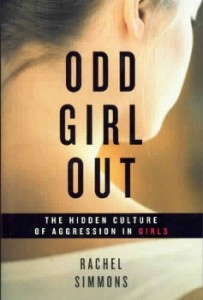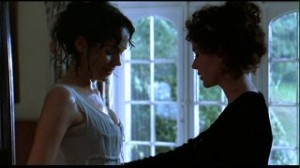 Sometimes as a parent, I need to read books like this one: Odd Girl Out: The Hidden Culture of Aggression in Girls by Rachel Simmons, which addresses the covert bullying many girls partake in lieu of more overt, physical bullying which is more common in boys. Simmons explains that in many segments of our society where girls are still expected to be “nice” (while boys are encouraged to be competitive), girls do not develop healthy ways to be competitive or healthy and straightforward strategies for resolving conflicts. Instead, they develop alternative forms of aggression: manipulative “friendships”, shunning, gossip, etc.., often carried out under a veneer of “niceness”.
Sometimes as a parent, I need to read books like this one: Odd Girl Out: The Hidden Culture of Aggression in Girls by Rachel Simmons, which addresses the covert bullying many girls partake in lieu of more overt, physical bullying which is more common in boys. Simmons explains that in many segments of our society where girls are still expected to be “nice” (while boys are encouraged to be competitive), girls do not develop healthy ways to be competitive or healthy and straightforward strategies for resolving conflicts. Instead, they develop alternative forms of aggression: manipulative “friendships”, shunning, gossip, etc.., often carried out under a veneer of “niceness”.
Although many of the cases described are saddening, Simmons doesn’t demonize the aggressors, pointing out that roles often change and that the aggressors’ behavior is rooted in insecurity and the fear of being excluded themselves. There is a high price paid by those who are part of the “in” clique.
On a personal level, I found Simmons’s insights useful, along with some of her suggestions for parents and schools. It also shed some light on behaviors I’ve seen in adult groups that are predominantly female. Not everyone outgrows this stuff.
As a writer, I also found the book interesting in light of fiction and character development.
 Diane’s recent post, Mansfield Park Revisited had me thinking about how Jane Austen depicted alternative female aggression in her books. Clearly, it’s not a new phenomenon. Ladies of the gentry and aristocracy were certainly expected to be “nice” so alternative aggression likely flourished. One can see it in the relationship between Caroline Bingley and Jane Bennett in Pride and Prejudice, in the friendship of Catherine and Isabella in Northanger Abbey and definitely between Fanny and Mary in Mansfield Park.
Diane’s recent post, Mansfield Park Revisited had me thinking about how Jane Austen depicted alternative female aggression in her books. Clearly, it’s not a new phenomenon. Ladies of the gentry and aristocracy were certainly expected to be “nice” so alternative aggression likely flourished. One can see it in the relationship between Caroline Bingley and Jane Bennett in Pride and Prejudice, in the friendship of Catherine and Isabella in Northanger Abbey and definitely between Fanny and Mary in Mansfield Park.
Here’s an image from the infamous scene with lesbian undertones in the 1999 version of Mansfield Park. Although I’ll agree with critics that I never saw anything like that in the book, it does fit in with the model of manipulation, the pressure for the victim to tolerate behavior that makes her uncomfortable, with the underlying threat of loss of friendship.
My second full length Regency romance, The Incorrigible Lady Catherine, was the beginning of my “Three Disgraces” trilogy with heroines who met at boarding school and who, for various reasons, didn’t fit in and formed their own defensive alliance. So I’ve played with this issue before in my writing, although at the time of writing, I certainly didn’t understand the aggressors as well as Jane Austen must have.
Have you read other books, romance or not, where the concept of alternative aggression was used effectively?
 To celebrate the recent release of The Incorrigible Lady Catherine in paperback, I’ll give away one copy to a random commenter. Comment by next Thursday (1/17) and I will announce the winner on Friday (1/18).
To celebrate the recent release of The Incorrigible Lady Catherine in paperback, I’ll give away one copy to a random commenter. Comment by next Thursday (1/17) and I will announce the winner on Friday (1/18).
